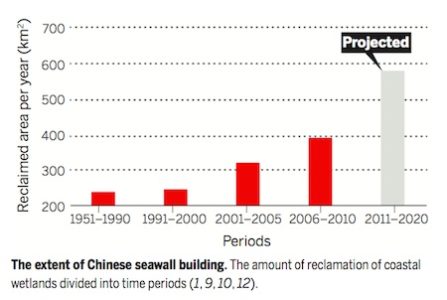 Is China’s rapidly expanding “new Great Wall”—a string of seawalls built to enable development—threatening the economic and environmental prosperity of the country’s coastal region? Yes, to the tune of $31 billion in losses each year, according to a recent article in Science Magazine. China’s seawalls, which now exceed the length of the Great Wall when taken together, cover 60% of China’s mainland coastline. Seawall building is increasingly threatening China’s coastal wetlands, which account for 25% of the world’s waterbird species and $200 billion in annual economic value (or 16% of China’s total). According to the article’s authors, led by Paulson Institute partner Ma Zhijun, seawalls are often used to enclose coastal wetlands for agricultural and industrial purposes, converting valuable wetlands from pollution sinks into pollution sources. While the central government has promulgated initial legislation to conserve the wetlands, these regulations do little to actually discourage wetlands destruction. Can China’s coastal wetlands be rescued? It remains to be seen, but the Paulson Institute’s “blueprint” project is a start. Together with China’s Wetland Management Office and the Chinese Academy of Sciences, the Paulson Institute is developing a series of policy recommendations for how and where to conserve these globally important habitats. If China can slow the growth of its “new Great Wall,” there may be hope for its coastal wetlands.
Is China’s rapidly expanding “new Great Wall”—a string of seawalls built to enable development—threatening the economic and environmental prosperity of the country’s coastal region? Yes, to the tune of $31 billion in losses each year, according to a recent article in Science Magazine. China’s seawalls, which now exceed the length of the Great Wall when taken together, cover 60% of China’s mainland coastline. Seawall building is increasingly threatening China’s coastal wetlands, which account for 25% of the world’s waterbird species and $200 billion in annual economic value (or 16% of China’s total). According to the article’s authors, led by Paulson Institute partner Ma Zhijun, seawalls are often used to enclose coastal wetlands for agricultural and industrial purposes, converting valuable wetlands from pollution sinks into pollution sources. While the central government has promulgated initial legislation to conserve the wetlands, these regulations do little to actually discourage wetlands destruction. Can China’s coastal wetlands be rescued? It remains to be seen, but the Paulson Institute’s “blueprint” project is a start. Together with China’s Wetland Management Office and the Chinese Academy of Sciences, the Paulson Institute is developing a series of policy recommendations for how and where to conserve these globally important habitats. If China can slow the growth of its “new Great Wall,” there may be hope for its coastal wetlands.
China’s New Great Wall
March 23, 2015


